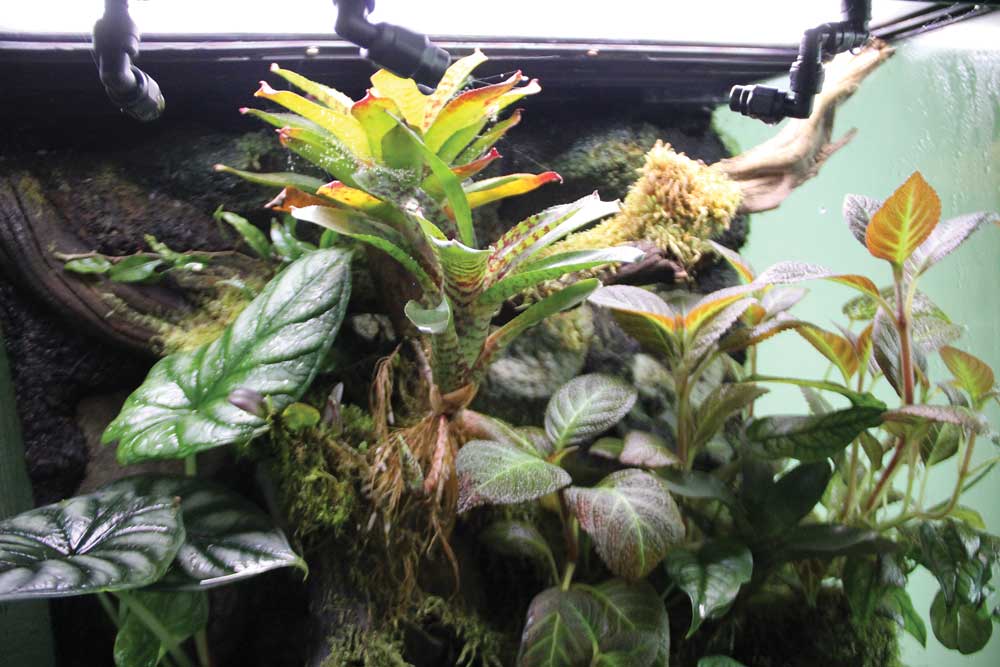In just five years, In Situ Ecosystems has built and outfitted terrariums that are designed to enable you to easily create rainforest habitats.
We started this adventure by asking ourselves how to create a long lasting and healthy rainforest terrarium. Rainforest terrariums are tricky to get to work because of inherent biological processes that can literally turn a well planted terrarium into a sludgy mess. In order to prevent this kind of occurrence, from an equipment view point, the terrarium needs good drainage (no horizontal surfaces that trap water), ventilation, i.e., fresh air entering into the terrarium, circulation (air movement within the terrarium), and good lighting for the plants you want to grow. So, we decided to review In Situ to see if its Amazonia line of terrariums can provide these essentials, and, provide a solution that can last for the years ahead.
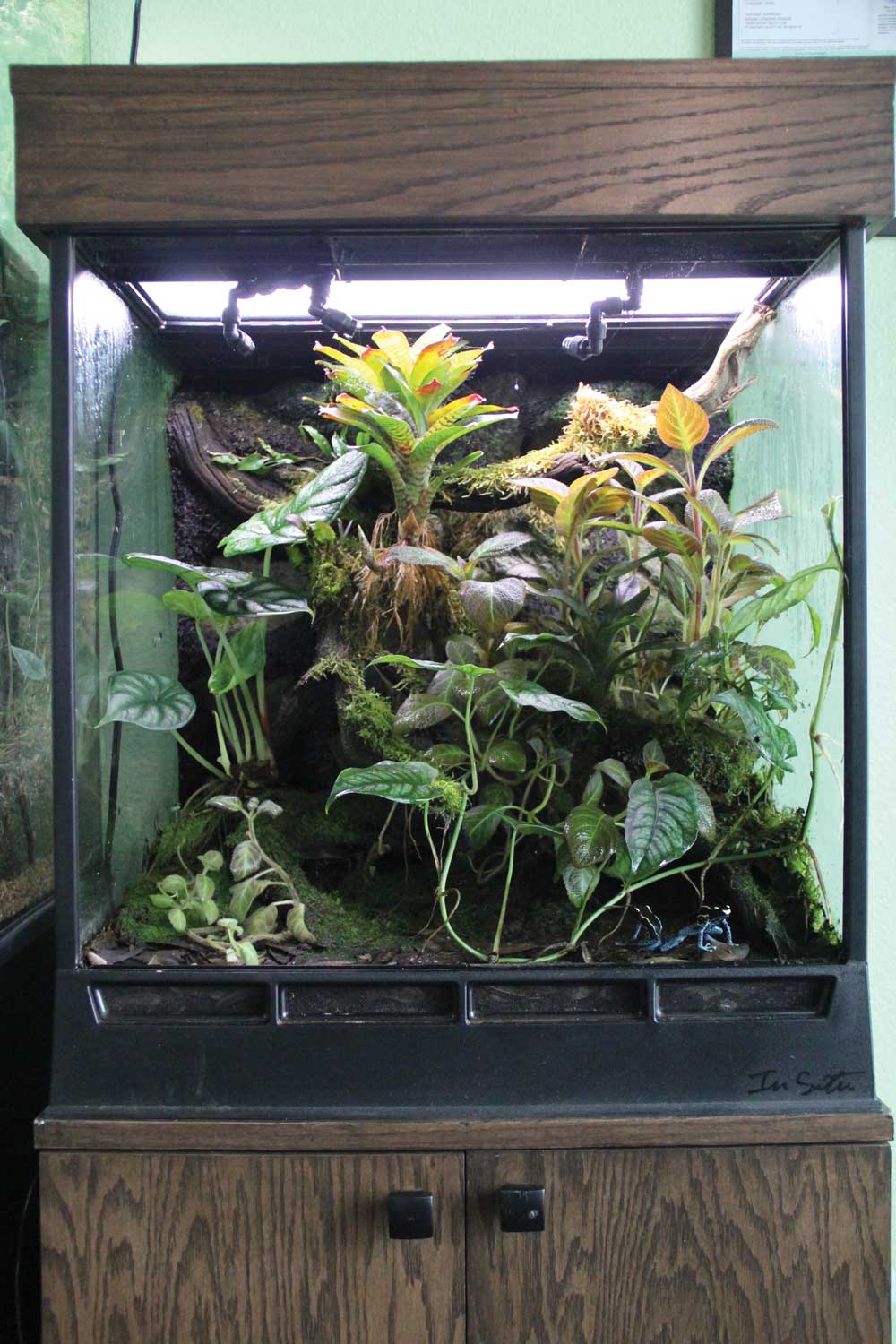
The Amazonia Classic is designed for high humidity herps, including poison frogs, crested geckos and other small gecko and lizard species. Photo by John Virata/Verdant Vivariums.
In just five years, In Situ Ecosystems has built and outfitted terrariums that are designed to enable you to easily create rainforest habitats. The company, which launched via a Kickstarter campaign, has taken a well thought out approach with its Amazonia Classic terrariums, truly creating a complete and integrated system with key partners. The Amazonia Classic terrarium is ideal for poison frogs, small gecko species and other small lizards and amphibians that benefit from high humidity environments. It is made right here in the USA.
The company is also currently working on the Alto Vista terrarium. This terrarium measures 46” x 36” x 18.” The purchase price for this system is expected to be between $1,500 and $2,000. The Amazonia Classic terrarium is available in 20” tall and 24” tall configurations. Prices start at $410. The terrarium is 17.5” deep and 22.25” wide. Standard equipment includes a sloped drainage deck, front and rear screen vent covers on the canopy, two circulation fans at the rear of the canopy, independent power supply, full spectrum LED lights and dimmer. The terrarium canopy is built into the rest of the system and is not user removable. It houses the built-in LED light system and the dual air circulation fans.
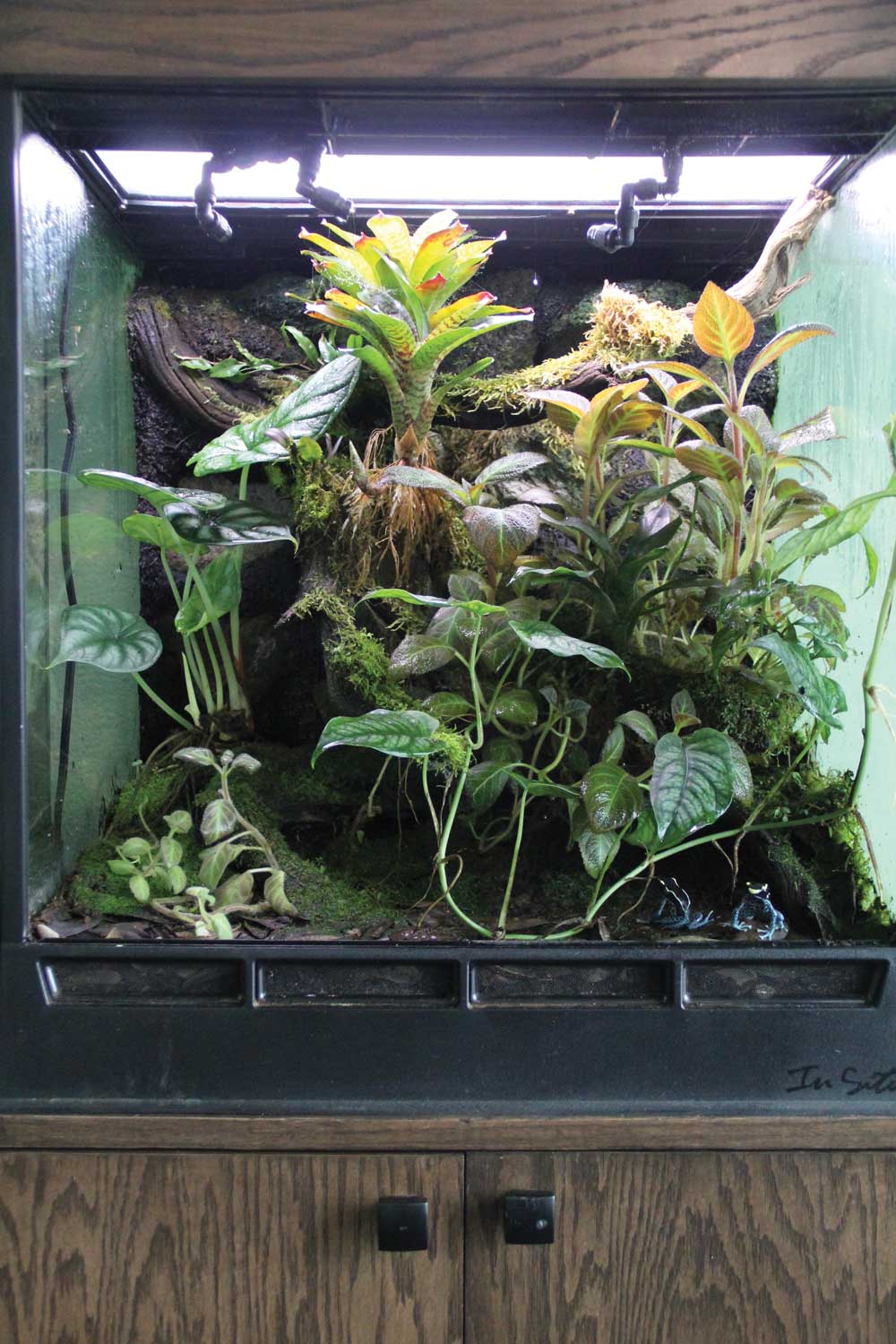
The LED light system is covered with a glass lens. Just behind the four vents is a sloped bottom that helps with drainage. Photo by John Virata/Verdant Vivariums.
The user removable items on the terrarium are the glass front doors, which are sliders that are removed like a sliding window, the vent covers in front of and the glass vent cover behind the LED light system, the two fans built into the rear of the canopy, and the LED lights.
The integration of the canopy into the terrarium prevents the escape of fruit flies and also helps maintain the desired humidity of the system. It gives the terrarium a more elegant and aesthetically-pleasing look. This particular canopy features three pre-drilled misting head holes in the front and three drill starts for misting head holes behind the light bay. This model shipped with glass sides and doors, and the standard model has a glass back. We received the upgraded version with the optional composite back panel.
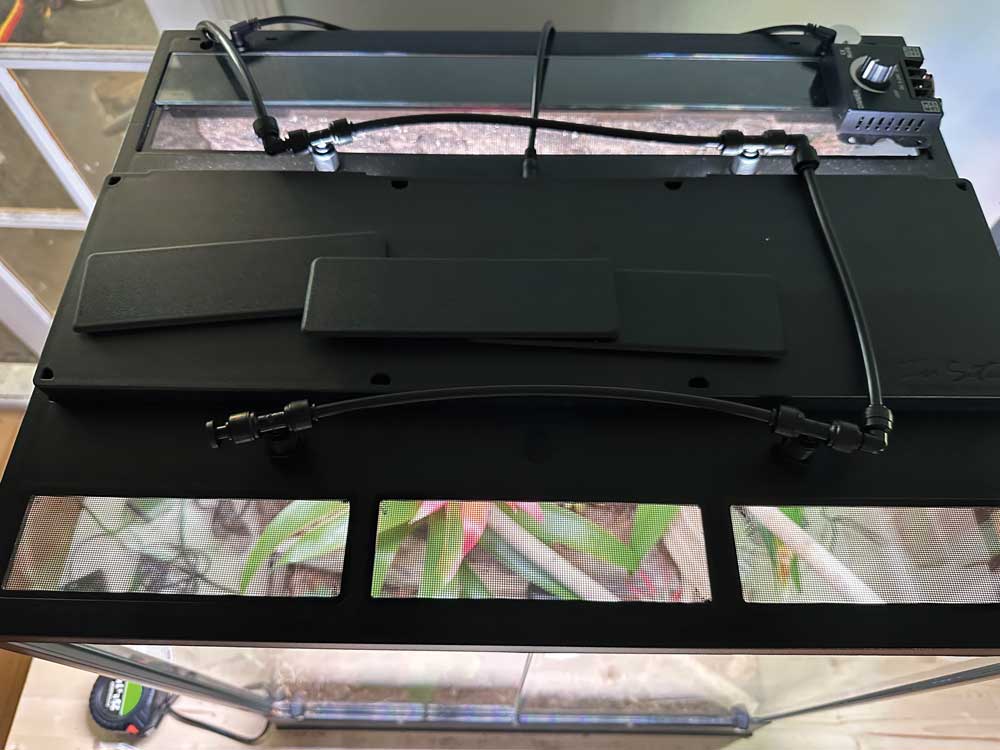
The hood supports three Mist King nozzles in the front and two in the rear. Photo by John Virata
On this version, the back of the terrarium is constructed of an aluminum/hollow core composite that reduces the weight of the vivarium considerably. The company also offers an all composite panel terrarium on the back and sides of the terrarium, which reduces the weight of the Amazonia 20 by 14 lbs (final weight with light system and glass door is 15 lbs.), 18 lbs for the Amazonia 24 (final weight with light system and glass door is 17 lbs.), and by up to 22 lbs. for the Alto model (final weight with light system and glass door is 20 lbs.). The only glass on the all composite panel system is the sliding doors and the sliding rear vent.
The Light System
The built-in light system comprises a little more than 1/3 of the canopy. It features six LED strips for a total of 44 watts of power, ideal for plants that prefer high light. The PAR value of the lights at about 6 inches from the canopy is about 250 at full strength. The high light values are geared toward those who keep orchids and bromeliads, which thrive on high light. The PAR value at the bottom of the terrarium is at around 150, ideal for low light plants, according to In Situ Ecosystems. A third party UVB light system is required for those animals that need UVB.
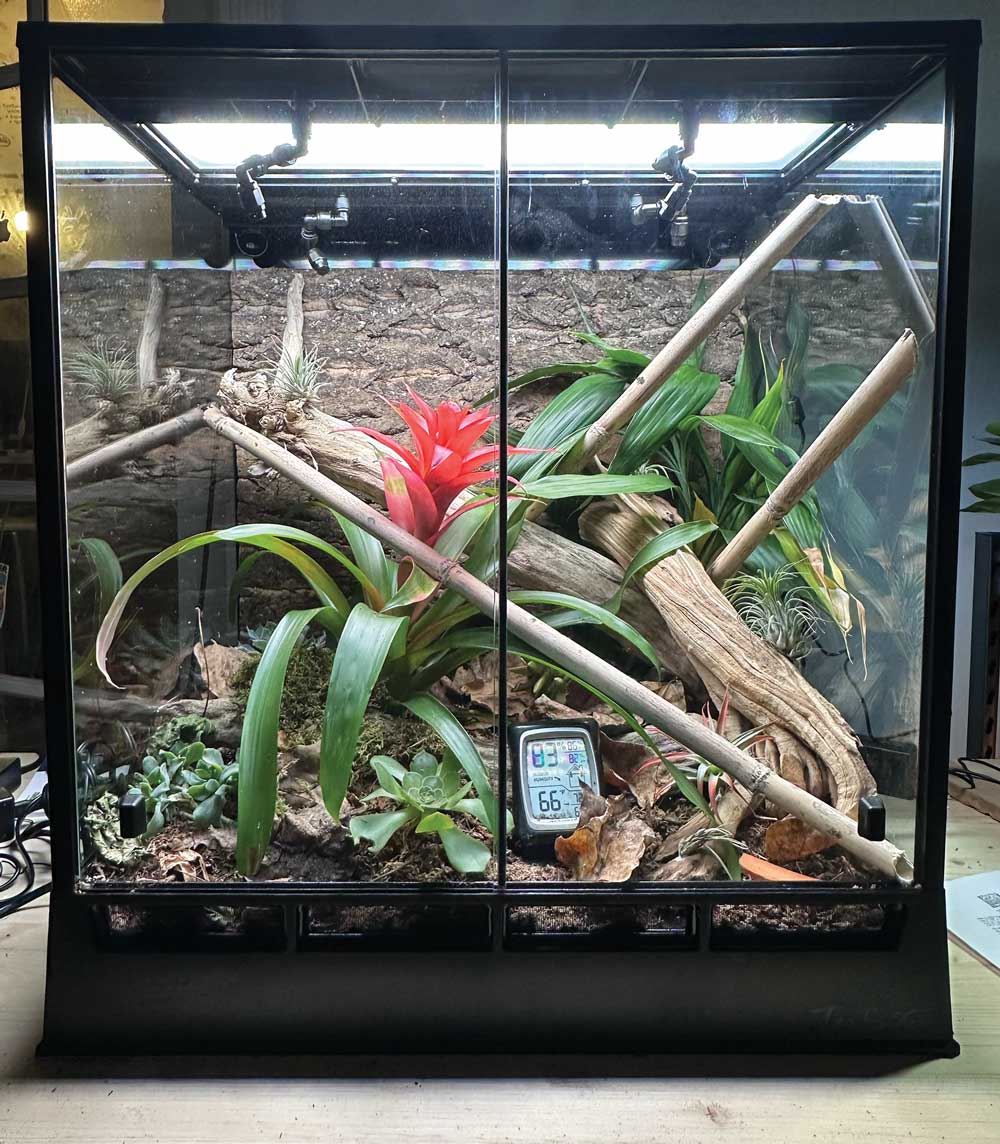
The Amazonia Classic. Photo by John Virata
Ventilation In the Bioactive Terrarium
Ventilation is an important aspect of any terrarium. The Amazonia Classic includes four powder coated stainless steel vent screens ( 4”x 1”) on the front of the enclosure near the bottom; three 6.25” x 2” inch powder coated stainless steel vent screens on the top front of the canopy, each with its own removable cover, so you can add or remove the covers depending on your humidity requirements; and a single 1.5” x 20” powder coated stainless steel vent screen on the rear of canopy that features a glass cover that you can open and close by sliding over the vent.
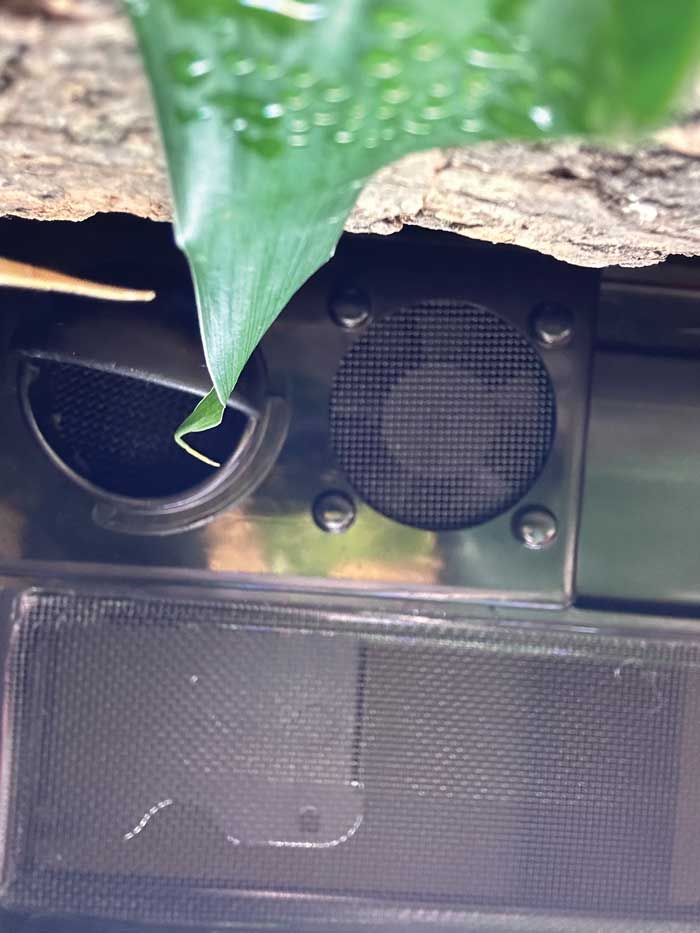
The fan systems ensures fresh air when needed. Photo by John Virata
The company has also taken the task of providing fresh air a step further with the addition of two water resistant circulation fans at the rear of the terrarium canopy. These fans are similar to small computer fans that you’d find in a small electronic device. In addition to the LED light system, the fans can be controlled via an optional Spectral Designs TC420 LED Programmable Time Controller that ships with the Amazonia Classic. The fan vents can be moved left and right to direct the flow of the forced air. The air exchange is rated at 6 times per minute. Two “dog tags” are located next to each fan that you can open and close to further force fresh air into the terrarium and further control humidity.
Bioactive Terrarium Drainage
The sloped drainage deck at the front of the terrarium has a tube that routes underneath the bottom and ends at the rear where you attach ordinary aquarium tubing into a receptacle. In Situ offers a reservoir to drain into, or you can come up with your own solution. With the In Situ Amazonia Classic, you no longer have to drill through glass to build your own bulkhead or siphon excess water from the top with aquarium tubing. It is all built in for you. No drilling. No mess.
Spectral Designs Digital Controller
In Situ Ecosystems (https://insituecosystems.com/) has partnered with Spectral Designs (https://spectraldesigns.com/) which offers its TC420 Digital LED Programmable Time Controller. When purchased from In Situ Ecosystems, the time controller is pre programmed for your local time zone. It is also programmed for 11, 12, 13, and 14 hour light cycles so your lights will simulate sunrise, mid-day peak and sunset with the light system. The cycles reach 100 percent power and then slowly back down to a sunset effect.
Misting Solutions For The Bioactive Enclosure
The canopy comes with three pre-drilled holes as standard. When you purchases the recommended mist head kit, In Situ drills two additional holes on the rear canopy bar and installs the heads for you. We chose the Recommended Kit because it ensures mist will reach the background and keep it moist. We also received a Mist King Starter Misting System (https://www.mistking.com/), which is the standard for herp terrariums. The system includes a pump and a timer that is simple to program, reservoir bulkhead fitting and filter (If you were to use a bucket or other water receptacle), five tubing clips, and 15 ft. of tubing.
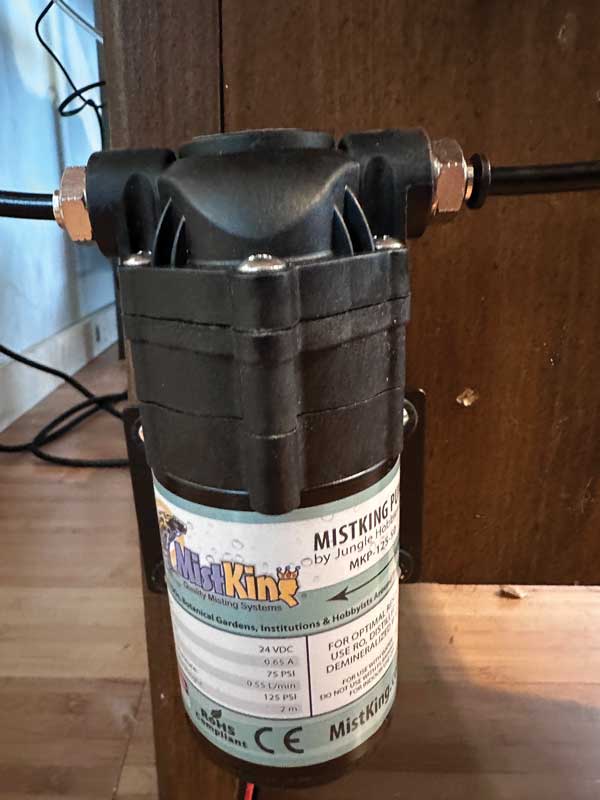
The Mist King systems pump attached to the side of the stand. Photo by John Virata
In Situ Ecosystems offers two solutions when you order a Mist King misting system from them. The standard kit offers two double misting heads installed on each corner of the vivarium (two L double misting assemblies, two 1/4 inch plug-in tees, one 1/4 plug-in elbow and one 1/4 inch tee). The Recommended Kit mentioned earlier adds two more heads toward the rear of the canopy, between the light system and the rear vent. It includes four L misting assemblies, four 1/4 inch plug-in tees, one 1/4 inch elbow and one 1/4 inch tee. Mist King recommends you read the manual before attempting to assemble the misting system. Reading the manual assured me a quick and seamless assembly and installation.
Conclusion
In Situ Ecosystems designs its solutions to make the user experience as seamless and plug and play as possible as well as satisfies the four critical requirements for drainage, ventilation, circulation, and lighting. In Situ has made the effort to think things through on its design, to even the simplest of things. One example is the power cords for the light and fan. They cannot be confused as they will only fit to its mate.
The company also ships a one sheet “Field Notes” that helped me immensely as I set up the terrarium. These “Tips for creating In Situ bioactive environments,” detail every feature of the terrarium and how they work to create the ideal environment for your poison frogs and smaller, humidity loving herps. LED lights are already built in and its partners, Mist King and Spectral Designs have helped to simplify the creation of a rainforest habitat for your own home.
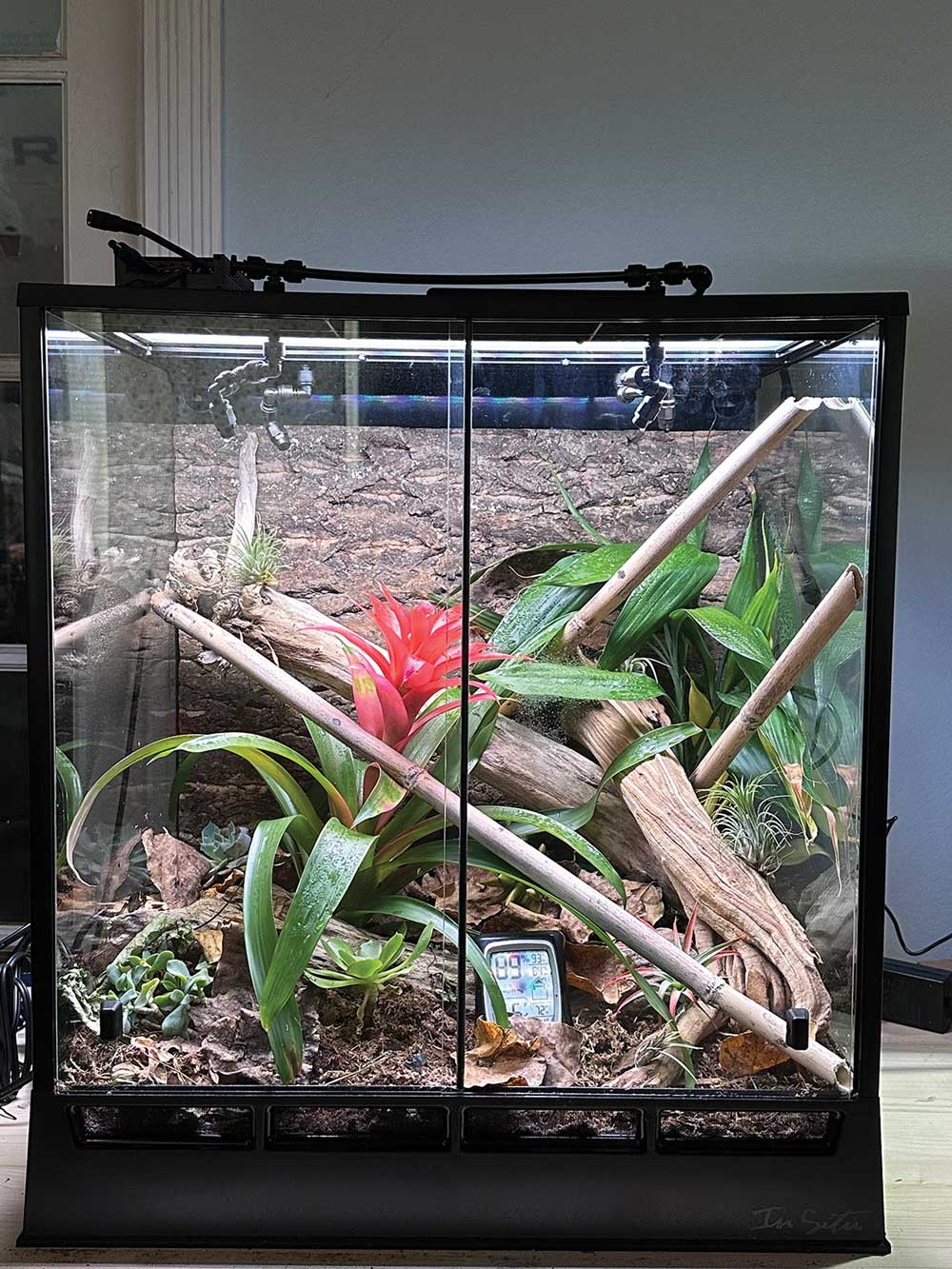
We added mopani wood, Zoo Med’s cork bark background, bamboo collected from the beach in Huntington Beach, CA, some Dracaena sanderiana, and some common air plants. The substrate is sphagnum moss, peat moss, tree fern fiber, Zoo Med’s ReptiBark and charcoal. The drain area is filled with Zoo Med’s Hydroballs covered with a thin substrate layer to to keep the rest of the substrate from getting into the drainage area.
The Amazonia Classic is a true plug-and-play terrarium system that provides all the necessary hardware to build a mini rainforest for your living room. It is a well thought out and designed system that works out of the box. To complete the build, In Situ offers rock background kits and accent rocks as well as a tower display stand designed to display your Amazonia terrarium while enabling you to hide the reservoirs for your misting system and drainage system behind a door.
In Situ Ecosystems Amazonia Classic
Starting at $425
https://insituecosystems.com/products/copy-of-amazonia
Spectral Designs
Digital Controller for In Situ Ecosystems
Additional Products Used in This Build
Mist King V 5.0 Starter Misting System
Zoo Med Natural Cork Tile Aquarium Background
Zoo Med Premium Repti Bark Natural Fir Reptile Bedding
Zoo Med HydroBalls Lightweight Expanded Clay Terrarium Substrate, 2.5-lb
Q&A With Bill Rodman, Founder of In Situ Ecosystems
REPTILES Magazine: What was the impetus in designing the Amazonia terrarium? What did you look at for inspiration?
Bill Rodman: When I first started, I couldn’t buy the sizes of terrariums that I wanted, and the ones I ordered on line would break during shipping. Those circumstances caused me to learn how to build them myself. Once I started making my own terrariums, I realized they were always wet and rotting organic materials were slowly turning everything to muck. So, I started trying to figure out why. Visits to the rainforest made me realize the rules about drainage and circulation. In Situ arose out of a realization that there was nowhere to go for people to get a properly functioning rainforest terrarium.
RM: Was the design of the Amazonia a collaborative effort?
BR: It was a collaborative effort. Todd Kelly, Chris Sherman, Ron Skylstad, and Kurt Jensen all provided comments as the design progressed.
RM: Why did you go with a thermoplastic base and canopy instead of something like PVC or other material?
BR: I wanted a higher quality material that I knew to be inert, would be long lasting and food safe.
RM: In Situ Ecosystems also offers a composite back panel Amazonia solution as well as a three-sided composite panel solution. What are the benefits and differences between the traditional glass enclosures and the composite terrarium that is available?
BR: The biggest difference is weight. There are many people that move periodically, and store their terrariums on racks that have weight limitations (normal baker’s racks do not hold a lot of weight). So, the composite back panel helps with reducing weight. On a baker’s rack, for example, the weight difference can be 50 lbs. or more. The composite back panel is one of our most popular upgrades.
RM: Will a UVB LED solution to complement the lighting system already built in be considered in future versions?
BR: Yes, definitely.
RM: The Amazonia has air vents in the lower front of the terrarium as well as in the front and rear of the canopy. Fans are also offered in the rear to circulate air. Most terrariums have a metal screen top for ventilation and some have front air vents. A full screen top can be a challenge regarding humidity. How did you balance the need for humidity and the need for fresh air in the enclosure?
BR: When designing a terrarium for the mass market, you have to remember that people live in many different climates, from moist and wet Washington, to dry, desert Phoenix. The vents are set up to help people regulate ventilation as they need to for their environment. If the terrarium needs more fresh air than can be accomplished with natural ventilation, the fans have a dog-tag that can be opened to force fresh air into the terrarium.

